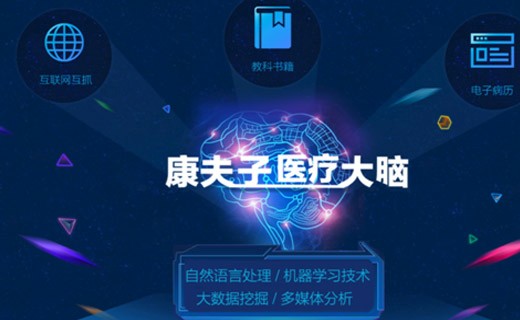When it comes to the prospects of medical artificial intelligence big data, the first thing we think about is how much of these black technology accuracy will be used when there is a large-scale application?

A recent test by a company called Kangfuzi said that their symptom diagnosis system has hit more than 90% of the typical symptoms of common diseases, more than 10% of the symptom checker of a top international medical clinic. At the same time, according to relevant data, the average misdiagnosis rate of various hospitals in China is around 30%.
Based on this, we contacted Mr. Zhang Chao, the founder of Kangfuzi. According to reports, from the technical point of view, its intelligent diagnosis is trained in three major steps.
Knowledge extraction: similar to doctors' memory medical knowledge. The primary task of medical AI is to build a medical knowledge map to support a range of applications. Knowledge maps have always been a must for major AI companies. Compared with semi-structured sites such as Wikipedia and Encyclopedia, Google and Baidu have built knowledge maps. Kangfuzi is based on unstructured text extraction to build knowledge maps. . Because of the complexity of medicine, its knowledge still exists in unstructured texts such as textbooks, essays, and popular science articles. According to reports, Kang Fuzi has a leading original technology in knowledge extraction:
1.) Their system can automatically learn from the massive literature to write a "law" of certain knowledge and then perform two large-scale automatic extraction;
2.) Designed a high performance computing framework to mitigate complex calculations.
Knowledge indicates that similar doctors are accumulating medical experience. After getting structured medical knowledge, Kang Fuzi wants to make this knowledge capable of reasoning. This is divided into two aspects,
1.) Knowledge vectorization representation, based on deep learning technology, vectorizes diseases and symptoms, and then realizes some reasoning behaviors. If the patient says "stomach is uncomfortable", the system will interact, is "disgusting", "stomach acid" or "Body bloating."
2.) The weight of the knowledge relationship is expressed. Many traditional probabilistic statistical models are based on independent hypotheses, but in reality this is unreasonable. For example, when deriving a possible disease based on a set of symptoms, the evolutionary logic between symptoms must be considered.
Logic application: Similar doctors are doing consultation services. Restricted and medical complexity and knowledge barriers are not just patients, sometimes even doctors can't think about it. At this time, the system needs to be able to interact intelligently, analyze the patient's condition, and make intelligent questions to obtain more patient characteristics.
When talking about the difference between the effects of traditional giants, Zhang Chao explained that the traditional diagnostic thinking quickly reached the bottleneck in effect, mainly because:
1. Knowledge scale: Most of the traditional diagnostic thinking uses the manually edited knowledge base. The knowledge base is small. Kangfuzi uses the international advanced information automatic extraction technology, and the number of diagnostic knowledge has exceeded 5 million;
2. Knowledge update: Here is an example. The typical symptom of lobar pneumonia is “rust rustâ€. This knowledge was discovered decades ago and is widely used in various clinical knowledge bases, but in today's clinical cases. , lobar pneumonia often does not have the "rust rust" phenomenon, because a considerable proportion of patients will take antibiotics (such as: amoxicillin) in the early stage, resulting in rust stains can be inconspicuous or not; traditional diagnostic tools The information update is lagging behind, resulting in a decline in diagnostic results.
3. Knowledge reasoning: Most traditional diagnostic thinking adopts the structure of decision tree. For example, patients complain of symptoms of “toothache, cough, headacheâ€. When traditional diagnostics see “toothacheâ€, they basically go to the diagnosis of periodontal disease. However, the intelligent diagnosis of Kangfuzi can be based on the knowledge base to reason that this "toothache" is caused by a cold, and then give a correct diagnosis.
4. Knowledge Representation: If the clinical tool is to be “groundedâ€, then it must be done in the natural language processing, so that the machine can understand the diversity of the user's description, which is also a difficult problem to be overcome by traditional diagnostic tools.
According to reports, the current Kang Fuzi has learned nearly 10,000 medical books, 20 million medical papers, and built a knowledge map for nearly 10,000 kinds of diseases, thousands of symptoms, laboratory indicators, medication response and other knowledge.
COVID-19 Infectious Disease Test Kit
Corona viruses are enveloped RNA viruses that are distributed broadly among humans,other
mammals,and birds and that cause respiratory,enteric,hepatic and neurologic diseases.
COVID-19 infectious diseases test Kit
NINGBO AUTRENDS INTERNATIONAL TRADE CO., LTD , https://www.metests.com